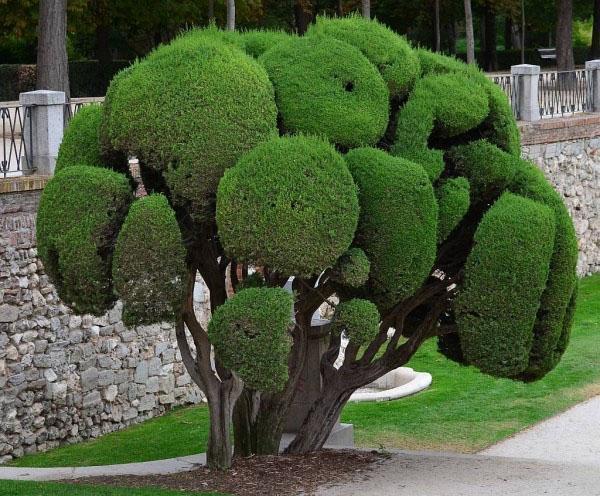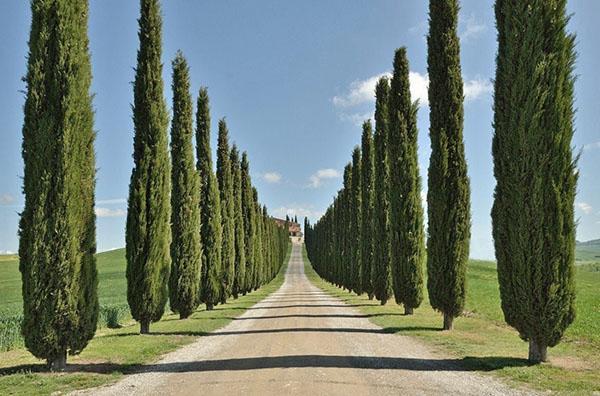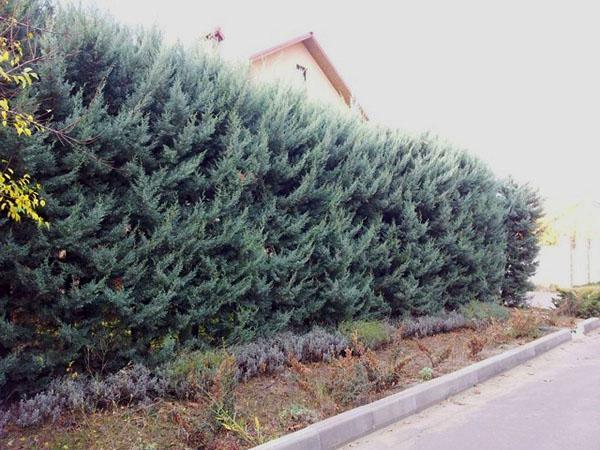The main types and varieties of cypress for the garden
 There are different types and varieties of cypress for the garden. All of them differ not only in appearance, but also in the method of cultivation. Observing the basic rules of planting and care, the bush will always be lush, healthy and incredibly beautiful.
There are different types and varieties of cypress for the garden. All of them differ not only in appearance, but also in the method of cultivation. Observing the basic rules of planting and care, the bush will always be lush, healthy and incredibly beautiful.
Cypress pyramidal or Italian

The tree has a crown resembling a column, the height of which sometimes reaches 35 meters. True, for this the cypress will need to grow for about a hundred years. The tree got its shape thanks to the active efforts of breeders. This long-liver also tolerates frost well, he is not afraid of indicators up to -20 °.
Likes pyramidal cypress to grow on hilly terrain, in the mountains, including on poor soils.
The needles of the pyramidal type of cypresses are small, rich-emerald, rather dark. Cones are formed on small twigs, they are brown with a gray tint. When a tree is young, it grows much faster. After 100 years in height, the Italian cypress no longer grows.
The pyramidal cypress tree is a real decoration for the alleys of parks and city squares. It looks great at a country house.
The most compact cypress varieties:
- Fastigiata Forluselu.
- Montrosa is a dwarf species.
- The indicator has a crown in the form of a column.
- The stricta is distinguished by a pyramid-shaped crown.
Cypress arizona
 The Arizona variety of cypress trees (C. arizonica) lives, of course, in America: Mexico and Arizona. Wild representatives of the plant took a fancy to the high mountain slopes and climbed up to 2.4 km in height. In 1882, beautiful trees began to be grown in gardens and parks, as well as at home.
The Arizona variety of cypress trees (C. arizonica) lives, of course, in America: Mexico and Arizona. Wild representatives of the plant took a fancy to the high mountain slopes and climbed up to 2.4 km in height. In 1882, beautiful trees began to be grown in gardens and parks, as well as at home.
Arizona cypress has become the basis for breeders to obtain such varieties of coniferous trees:
- Ashersoniana is a short variety.
- Compact is a shrub species, its green needles have a blue tint.
- Konica is similar in shape to a skittle, a poor wintering variety with a characteristic bluish-gray needles.
- Pyramidalis - crown-cone and blue needles.
Representatives of this species of the cypress family live up to 500 years, while growing 20 meters. Differs in a bluish shade of needles. The color of the bark of these cypress trees varies with the age of the tree. The bark of young twigs is gray, over time it acquires a brown tint.
They change color and cones as they ripen: at first they are brown with a reddish tint, and then they turn blue.
Arizona cypress stands out from its counterparts for its wood characteristics. She resembles a little nut, solid and weighs a lot. The tree prefers not too cold winters, but is able to withstand a short cold down to -25 °, and can endure dry periods. In growth, it adds very quickly.
Mexican cypress
 Сupressus lusitanica Mill - this is the Latin name for the Mexican cypress, which grows freely in the vastness of Central America. Portuguese naturalists compiled a portrait of the tree as early as 1600. The Mexican representative of conifers grows up to 40 meters and has a wide crown, similar in shape to a pyramid.The branches are covered with ovoid needles, a dark green shade. Miniature cones no more than 1.5 cm in diameter form on the tree. Young fruits are green with a blue tint, and turn brown as they ripen.
Сupressus lusitanica Mill - this is the Latin name for the Mexican cypress, which grows freely in the vastness of Central America. Portuguese naturalists compiled a portrait of the tree as early as 1600. The Mexican representative of conifers grows up to 40 meters and has a wide crown, similar in shape to a pyramid.The branches are covered with ovoid needles, a dark green shade. Miniature cones no more than 1.5 cm in diameter form on the tree. Young fruits are green with a blue tint, and turn brown as they ripen.
The domesticated Mexican cypress cannot withstand severe frosts and dies in drought.
The most popular varieties are:
- Bentama - its distinctive feature is that the branches grow in the same plane, because of this the crown is narrow, and the needles are painted in a gray color.
- Glauka - it stands out with a blue shade of needles and the same color of cones, the branches are located in the same plane.
- Tristis (sad) - the shoots of this variety are directed downward, and the crown resembles a column.
- Lindley - is distinguished by large cones, as well as dense, rich green branches.
Swamp cypress
 As soon as this variety of cypress is not called: marsh, Taxodium is two-row, in Latin it sounds like Taxodium distichum. It owes its name to the fact that it grows in the wild in the wetlands of North America, especially in Louisiana and Florida. The name two-row comes from the characteristic arrangement of the leaves on the branches. Since the 17th century, this species has been domesticated throughout Europe. A photo of a swamp cypress is presented below.
As soon as this variety of cypress is not called: marsh, Taxodium is two-row, in Latin it sounds like Taxodium distichum. It owes its name to the fact that it grows in the wild in the wetlands of North America, especially in Louisiana and Florida. The name two-row comes from the characteristic arrangement of the leaves on the branches. Since the 17th century, this species has been domesticated throughout Europe. A photo of a swamp cypress is presented below.
It is a very large and tall tree. There are specimens above 35 meters. The massive trunk reaches 12 m in diameter, its bark is dark red, very thick (10-15 cm).
Swamp cypress belongs to the deciduous species, it sheds needles that resemble an awl.
The toxodium is two-rowed easily recognizable by its special horizontal roots. They grow at a height of 1-2 m and look like bottles or cones. Sometimes only a few of them grow, and sometimes so many that it turns out a whole wall of pneumatophores. Such a root system provides additional respiration to the tree, so a long stay in the water for the marsh cypress is not scary.
When choosing cypress varieties for decorating a garden, it is necessary to take into account not only its size, features of the crown and needles, but also the resistance of the varieties to negative external factors.
Common cypress or evergreen
 Wild varieties of evergreen cypress trees are exclusively horizontal representatives inhabiting the mountains of Asia Minor, Iran, and also living on the islands of Crete, Rhodes and Cyprus.
Wild varieties of evergreen cypress trees are exclusively horizontal representatives inhabiting the mountains of Asia Minor, Iran, and also living on the islands of Crete, Rhodes and Cyprus.
The pyramid-like varieties were formed when they were planted in Western Asia and the Mediterranean countries. The crown of such trees is narrow due to the short branches that sit tightly against the trunk. Common cypress is like a cone. He is able to grow up to 30 m in height.
Small needles, like scales, elongated, tightly nestle on the branches in a cruciform manner. Cones hang down on short shoots, they are about 3 cm in diameter, gray with brown tints. This species grows very quickly.
There is a red variety of cypress with exotic colors of needles.
Horizontal cypress feels good in the shade. Withstands up to -20 ° C. Does not be capricious about the soil and the presence of stones in it, lime. They do not interfere with its growth. But excessive moisture is very harmful to the tree. This variety, like the rest of the cypress trees, is a long-liver. Bumps begin to appear at the age of five.
Frost-resistant cypress is not afraid of cutting, which is important for decorative purposes. Therefore, neat, pyramid-like trees are actively used by landscape designers when registration of plots and especially parks. The specimens are not planted singly and in the form of an alley. Small groups of coniferous representatives look most advantageous.
Cypress evergreen Apollo
 This type of tree prefers warm regions in the south. It is also called slender because of its particularly narrow, conical crown. The evergreen Apollo cypress is considered a symbol of youth. The branches, tightly pressing against the trunk, rise up. The cones are round and patterned, and the needles are small and soft.The young plant rapidly gains in growth, adult specimens rise to 30 meters.
This type of tree prefers warm regions in the south. It is also called slender because of its particularly narrow, conical crown. The evergreen Apollo cypress is considered a symbol of youth. The branches, tightly pressing against the trunk, rise up. The cones are round and patterned, and the needles are small and soft.The young plant rapidly gains in growth, adult specimens rise to 30 meters.
Apollo's cypress is capable of hibernating at -20 ° C, but prolonged frosts are undesirable for him. An adult tree is resistant to drought; young plants need to be watered for the first time. The trees should be planted in shaded areas. The coniferous representative will grow even on slightly saline and rather dry soils. He is not picky about soils.
Young specimens are unstable to winds, they should be planted in the area between buildings.
Dwarf cypress
 Plants of short stature are especially popular due to their compactness. Gardeners liked the Caespitosa variety more than others. It develops very slowly, shoots grow by 5 mm in a year. This look looks more like a pillow than a classic tree. The needles are very small, green.
Plants of short stature are especially popular due to their compactness. Gardeners liked the Caespitosa variety more than others. It develops very slowly, shoots grow by 5 mm in a year. This look looks more like a pillow than a classic tree. The needles are very small, green.
Dwarf cypress has a flat shape. It is presented in the form of a bush no more than half a meter high. The branches of the plant are thin, glossy. The needles have a beautiful color: green with a blue tint.
American cypress is also popular. This is a representative who loves a lot of sun. The color of the plant is light green. It features a bare crown at the base and a rather lush top. An adult tree will grow up to 7 meters high.